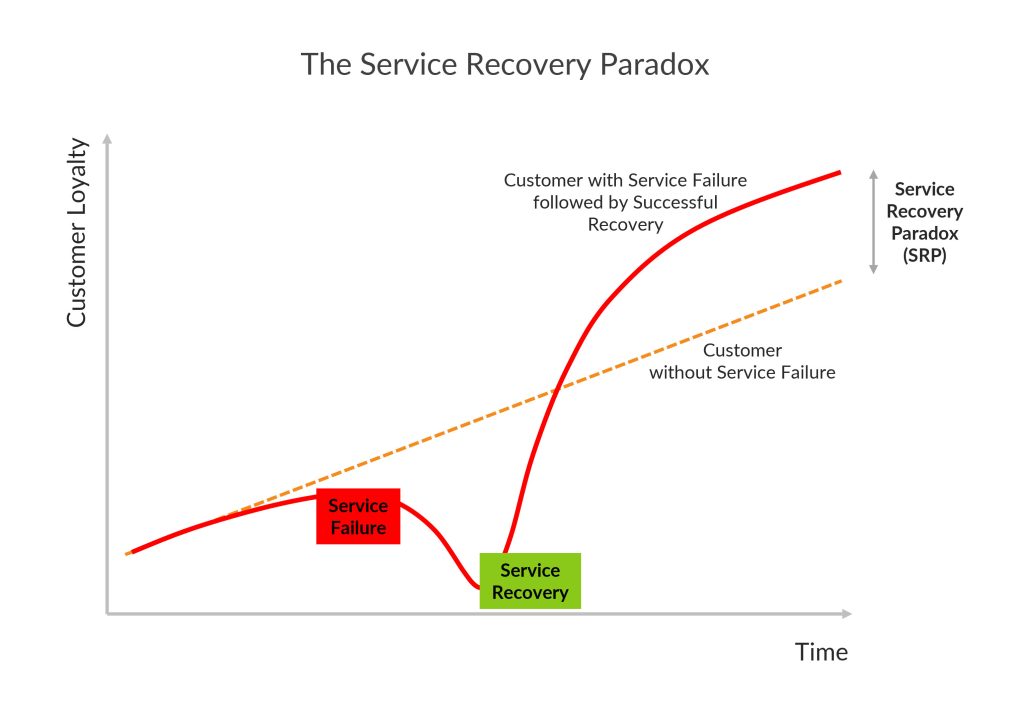A couple of years ago, I wrote a blog called The Service Recovery Paradox – Fact or Myth? Today I’m looking more specifically at whether the Service Recovery Paradox is true for business-to-business (B2B) relationships.
But first, a quick recap on the basics of SRP.

The Service Recovery Paradox is a concept that was first introduced by service management guru Christopher Hart in the Harvard Business Review way back in 1990. Here’s what he said more than 30 years ago:
“A good recovery following a service failure can turn angry, frustrated customers into loyal ones. It can, in fact, create more goodwill than if things had gone smoothly in the first place.”
Sounds great. But is it true? Or, as some other academics have asked more bluntly, is it a more of a smouldering myth than a justifiable theory?
Like most things in life, the answer is nuanced.
The evidence – and there really is little of it out there as I discussed in that blog – suggests that in most circumstances the Service Recovery Paradox is simply not true.
When a company does a really good job at fixing the service issue, Satisfaction can go back up to – and even beyond – pre-failure levels. But here’s the rub. Even though Satisfaction recovers, Loyalty does not. So, to summarise that earlier blog, the Service Recovery Paradox (SRP) is indeed a smouldering myth, at least in the consumer world.
The basic message in that blog was to get the basics right, rather than trying to recover a bad situation. Do things right, and do them right first time. Reliable and consistent service delivery is the cornerstone of long-lasting client relationships. And it doesn’t cost anything to ensure consistency of service delivery because Quality is Free.
But what about the B2B world?
All the case studies mentioned in that previous research were from the consumer world. Do the same conclusions hold true for B2B companies? Is the Service Recovery Paradox true for B2B relationships? I was curious to find out.
It turns out that there is even less written about B2B service failures than consumer service disasters. That said, three Swiss consultants – Denis Hübner, Stephan Wagner and Stefan Kurpjuweit – did examine B2B service failure and subsequent recovery in the logistics industry. They interviewed senior managers and front line workers in 25 different companies across three continents and came up with some interesting conclusions.
In summary, they did find some evidence to support a positive aftermath after a service failure. However, they could only find evidence for the SRP in nine of the 25 cases that they investigated. That means that in nearly two thirds of cases, there was zero evidence of any recovery after a service failure.
And here’s a more interesting finding. In those nine cases, the discussion is around satisfaction. There is no mention of increased loyalty in any of the cases. Yes, in nine cases and under quite specific circumstances, satisfaction did recover to pre-failure levels. But there is no discussion about increased purchases or purchasing intentions. Nothing about deeper relationships or increased levels of trust.
In other words, loyalty appears to be remain compromised even when B2B service providers implement an excellent service recovery.
This suggests that the SRP truly is a “smouldering myth” in both the B2B world as well as the consumer world.
Now let’s look at some of the nuances in their research, because there are some good messages for B2B leaders to take on board.
The analysis of those nine cases where satisfaction improved after a successful service recovery led Hübner and his colleagues to a couple of key conclusions:
The corollary is also true. If the service failure is low-impact and part of an ongoing systemic problem, it’s almost impossible to recover from, because it rarely gets taken seriously by leadership teams.
Even when the service failure is seen to be in the “that was massive and nobody could have predicted it” category, a lot of hard work is required to rebuild satisfaction level afterwards. A few points are worth noting:
When you read Hübner’s article in detail, it’s hard to come to any other conclusion than the only successful way of ensuring loyal customers is to prevent service failures from happening in the first place. That’s the same conclusion as in my earlier blog.
Easier said than done.
That means going back to the old principles of Total Quality Management (TQM) and “getting it right first time”. Remember that it’s easier and cheaper to build quality in at the start than it is to firefight when things go wrong.
A final thought: even when B2B service providers do everything to prevent service failures, they still happen. When they do, act quickly and learn how to say sorry, even if an apology on its own has limited value.
Contact us if you want to find out what your clients think of your service. And if you’re not sure how to say sorry, our friends in Corporate Visions may be able to help!